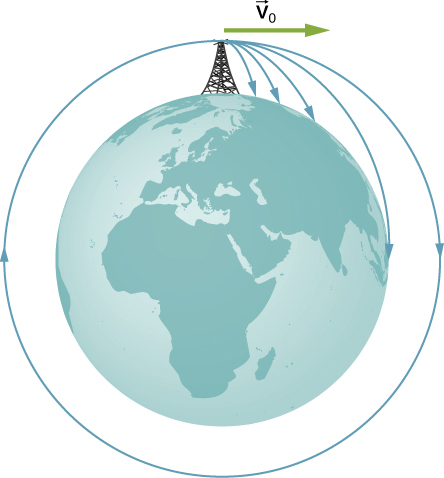| << Chapter < Page | Chapter >> Page > |
Check Your Understanding If the two golf shots in [link] were launched at the same speed, which shot would have the greatest range?
The golf shot at
When we speak of the range of a projectile on level ground, we assume R is very small compared with the circumference of Earth. If, however, the range is large, Earth curves away below the projectile and the acceleration resulting from gravity changes direction along the path. The range is larger than predicted by the range equation given earlier because the projectile has farther to fall than it would on level ground, as shown in [link] , which is based on a drawing in Newton’s Principia . If the initial speed is great enough, the projectile goes into orbit. Earth’s surface drops 5 m every 8000 m. In 1 s an object falls 5 m without air resistance. Thus, if an object is given a horizontal velocity of (or near Earth’s surface, it will go into orbit around the planet because the surface continuously falls away from the object. This is roughly the speed of the Space Shuttle in a low Earth orbit when it was operational, or any satellite in a low Earth orbit. These and other aspects of orbital motion, such as Earth’s rotation, are covered in greater depth in Gravitation .

At PhET Explorations: Projectile Motion , learn about projectile motion in terms of the launch angle and initial velocity.
Answer the following questions for projectile motion on level ground assuming negligible air resistance, with the initial angle being neither nor (a) Is the velocity ever zero? (b) When is the velocity a minimum? A maximum? (c) Can the velocity ever be the same as the initial velocity at a time other than at t = 0? (d) Can the speed ever be the same as the initial speed at a time other than at t = 0?
a. no; b. minimum at apex of trajectory and maximum at launch and impact; c. no, velocity is a vector; d. yes, where it lands
Answer the following questions for projectile motion on level ground assuming negligible air resistance, with the initial angle being neither nor (a) Is the acceleration ever zero? (b) Is the acceleration ever in the same direction as a component of velocity? (c) Is the acceleration ever opposite in direction to a component of velocity?

Notification Switch
Would you like to follow the 'University physics volume 1' conversation and receive update notifications?